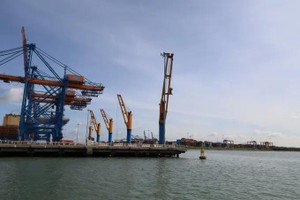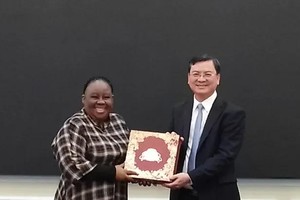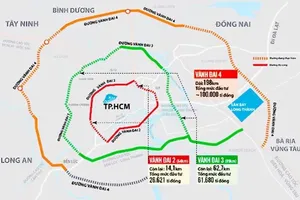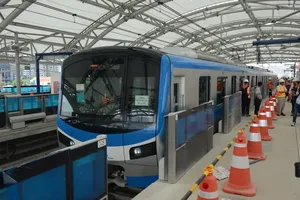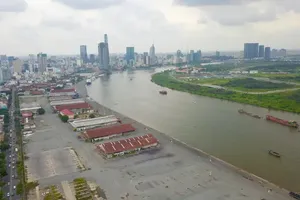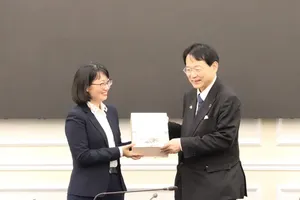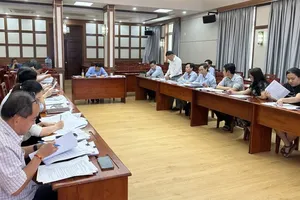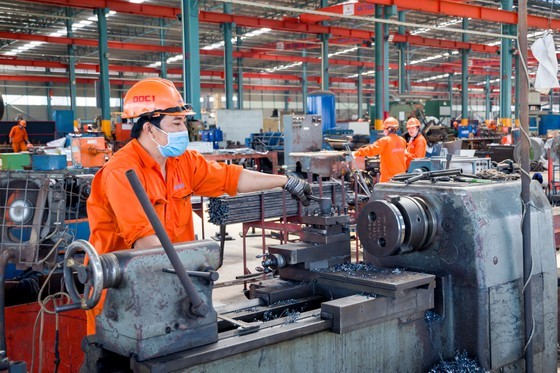 Workers are longing for the day they return to work. (Photo: SGGP)
Workers are longing for the day they return to work. (Photo: SGGP)
Orders abundant, labor insufficient
Two weeks ago, Ngo Van Thanh, a worker of Vy Chau Company in District 7 in HCMC, called the Fellow Countrymen Association of Soc Trang Province in HCMC to ask for its support to help him and his wife, who is 7-month pregnant, to return home. When there was a program to bring people back to the province, Thanh stayed, and only his wife returned to their hometown.
“The company has just announced that it is preparing to resume production and calling for workers to register. I have stopped working for nearly three months. Now, I am so happy to hear that I am going to return to work," he said. Thanh is one of hundreds of thousands of workers of many businesses who are happy to hear that their companies will resume production.
Not so lucky, Tran My Linh, a worker from Phu Yen Province at Linh Trung 2 Export Processing Zone, returned to her hometown when her company temporarily suspended production due to the pandemic. Lately, her team leader announced on the Zalo group that her company was making a list of eligible employees to return to work, so she also applied but did not know how to return to HCMC.
“I had the first dose of Covid-19 vaccine when I was at work. Now, it is time for the second dose, but I cannot register for injection in my hometown nor go back to HCMC. The company is calling for workers to return to work, but I do not know what to do," Linh said.
To prepare for the restoration of production, in mid-September, Vy Chau Company informed its units to contact workers and calculate the number of workers eligible to return to work. “Most employees were vaccinated with the first dose of Covid-19 vaccine, but nearly 30 percent of workers have returned to their hometown, some are Covid-19 patients, and some do not reside in the green zones. It makes the company unable to have enough workers when restarting production,” Mr. Dinh Tuan Kiet, Chairman of the Trade Union of Vy Chau Company, said worriedly.
As a food enterprise, Vinh Thanh Dat Food Company is preparing to enter the peak production for the Tet festive season, with abundant orders. However, the company now faces a serious labor shortage, although it has been carrying out the three-on-site production model.
Mr. Truong Chi Thien, Director of Vinh Thanh Dat Food Company, said that the company has a modern machinery system, but it faces a shortage of 50 percent of employees. As a result, the maximum capacity is only 70 percent compared to before and cannot meet the requirements of the current orders.
Meanwhile, Mr. Truong Tien Dung, General Director of APT Company, informed that all the employees had had two doses of the Covid-19 vaccine, but it is still difficult to meet the four-green requirements requested by the city.
Mr. Truong Tien Dung said that in the process of restoring production when returning to the new normal, enterprises would face many difficulties, including testing cost, scarce raw materials, price increase, labor competition, increasing labor cost. Not to mention that enterprises will have to train their employees again to arrange into positions with a labor shortage in production lines.
Solving the vaccination problem
HCMC currently has 17 export processing zones, industrial parks, and high-tech parks, with nearly 1,600 enterprises and more than 320,000 workers. In which, more than 820 factories have halted operations, with nearly 245,000 workers having to temporarily stop working. Many employees were worried about the developments of the Covid-19 pandemic in HCMC, so they returned to their hometown to avoid the pandemic.
According to statistics, since July, the HCMC Department of Transport has coordinated with localities to bring 33,000 people back to 34 provinces and cities, besides the number of workers returning to their hometowns by their own vehicles. It has caused labor shortages in most sectors and industries.
Two weeks ago, Ngo Van Thanh, a worker of Vy Chau Company in District 7 in HCMC, called the Fellow Countrymen Association of Soc Trang Province in HCMC to ask for its support to help him and his wife, who is 7-month pregnant, to return home. When there was a program to bring people back to the province, Thanh stayed, and only his wife returned to their hometown.
“The company has just announced that it is preparing to resume production and calling for workers to register. I have stopped working for nearly three months. Now, I am so happy to hear that I am going to return to work," he said. Thanh is one of hundreds of thousands of workers of many businesses who are happy to hear that their companies will resume production.
Not so lucky, Tran My Linh, a worker from Phu Yen Province at Linh Trung 2 Export Processing Zone, returned to her hometown when her company temporarily suspended production due to the pandemic. Lately, her team leader announced on the Zalo group that her company was making a list of eligible employees to return to work, so she also applied but did not know how to return to HCMC.
“I had the first dose of Covid-19 vaccine when I was at work. Now, it is time for the second dose, but I cannot register for injection in my hometown nor go back to HCMC. The company is calling for workers to return to work, but I do not know what to do," Linh said.
To prepare for the restoration of production, in mid-September, Vy Chau Company informed its units to contact workers and calculate the number of workers eligible to return to work. “Most employees were vaccinated with the first dose of Covid-19 vaccine, but nearly 30 percent of workers have returned to their hometown, some are Covid-19 patients, and some do not reside in the green zones. It makes the company unable to have enough workers when restarting production,” Mr. Dinh Tuan Kiet, Chairman of the Trade Union of Vy Chau Company, said worriedly.
As a food enterprise, Vinh Thanh Dat Food Company is preparing to enter the peak production for the Tet festive season, with abundant orders. However, the company now faces a serious labor shortage, although it has been carrying out the three-on-site production model.
Mr. Truong Chi Thien, Director of Vinh Thanh Dat Food Company, said that the company has a modern machinery system, but it faces a shortage of 50 percent of employees. As a result, the maximum capacity is only 70 percent compared to before and cannot meet the requirements of the current orders.
Meanwhile, Mr. Truong Tien Dung, General Director of APT Company, informed that all the employees had had two doses of the Covid-19 vaccine, but it is still difficult to meet the four-green requirements requested by the city.
Mr. Truong Tien Dung said that in the process of restoring production when returning to the new normal, enterprises would face many difficulties, including testing cost, scarce raw materials, price increase, labor competition, increasing labor cost. Not to mention that enterprises will have to train their employees again to arrange into positions with a labor shortage in production lines.
Solving the vaccination problem
HCMC currently has 17 export processing zones, industrial parks, and high-tech parks, with nearly 1,600 enterprises and more than 320,000 workers. In which, more than 820 factories have halted operations, with nearly 245,000 workers having to temporarily stop working. Many employees were worried about the developments of the Covid-19 pandemic in HCMC, so they returned to their hometown to avoid the pandemic.
According to statistics, since July, the HCMC Department of Transport has coordinated with localities to bring 33,000 people back to 34 provinces and cities, besides the number of workers returning to their hometowns by their own vehicles. It has caused labor shortages in most sectors and industries.
 Nguyen Dung Textile and Garment Company in District 12 prepares for workers to return to work when they have received two doses of the Covid-19 vaccine. (Photo: SGGP)
Nguyen Dung Textile and Garment Company in District 12 prepares for workers to return to work when they have received two doses of the Covid-19 vaccine. (Photo: SGGP)
Mr. Chu Tien Dung, Chairman of HCMC Union of Business Associations, said that the labor shortage in enterprises under the three-on-site production model was at 30 percent. However, in enterprises that have stopped production for a long time, or garment and textile enterprises with many workers from other provinces, labor shortages might range from 60 percent to 70 percent. Particularly, wood processing enterprises in HCMC and Southern provinces seem to be sitting on pins and needles because they have received orders until March and April next year, but the number of workers is only a quarter of that before social distancing. To ensure the delivery schedule, the wood processing industry is forced to choose an immediate solution, which is to recruit local workers. Vaccination for workers to participate in safe production is another concern of enterprises. This problem is also the biggest barrier when most workers have returned to their hometowns and do not have access to Covid-19 vaccines. "First, HCMC and the Government need to create conditions for workers to return to the city to participate in production, and at the same time provide enough vaccines for them," Mr. Chu Tien Dung suggested. According to the Chairman of HUBA, about 90 percent of workers who stay in the city have been vaccinated with the first dose, and 30 percent of workers have been given the second dose. Noticeably, in enterprises in industrial parks, export processing zones, and hi-tech parks that are carrying out the three-on-site production, the number of workers who received two injections can reach 70 percent. However, workers who returned to their hometowns may have had one injection or have not received any injection. It is a big difficulty for workers to participate in safe production. Regarding this issue, Dr. Nguyen Hong Tam, Deputy Executive Director of the HCMC Center for Disease Control, said that the city health sector estimated that the city would have enough vaccines to meet the number of workers who will return to the city to work after October 1. As for the reopening, Ho Chi Minh City is urgently developing 14 strategies, including health, labor, and employment strategies. The municipal People's Committee also assigned the Department of Transport to develop a plan to coordinate with provinces and cities to welcome workers back to the city for work. It is also an option to create conditions for both employees and businesses to solve the problem of human resources when operating again.
According to statistics of the Employment Service Center of HCMC under the Department of Labor, Invalids, and Social Affairs of HCMC, currently, 325 businesses have registered to recruit 1,300 workers. According to Mr. Tran Anh Tuan, Vice Chairman of HCMC Vocational Education Association, unskilled labor is not the priority of enterprises because the restoration of production and business activities is carried out according to the roadmap, and labor demand also needs to take steps.
Currently, the number of workers remaining in the city is also relatively high. However, in the near future, businesses will have a shortage of skilled and high-quality workers to take on jobs that require connectivity and meet the needs of the fourth industrial revolution.
Currently, the number of workers remaining in the city is also relatively high. However, in the near future, businesses will have a shortage of skilled and high-quality workers to take on jobs that require connectivity and meet the needs of the fourth industrial revolution.

